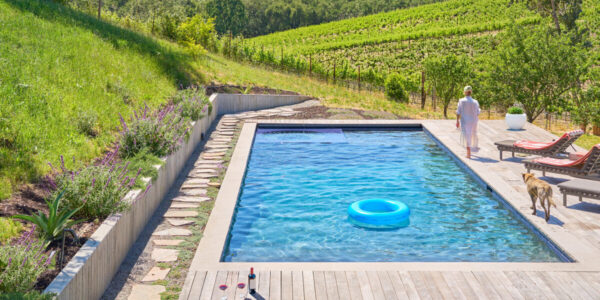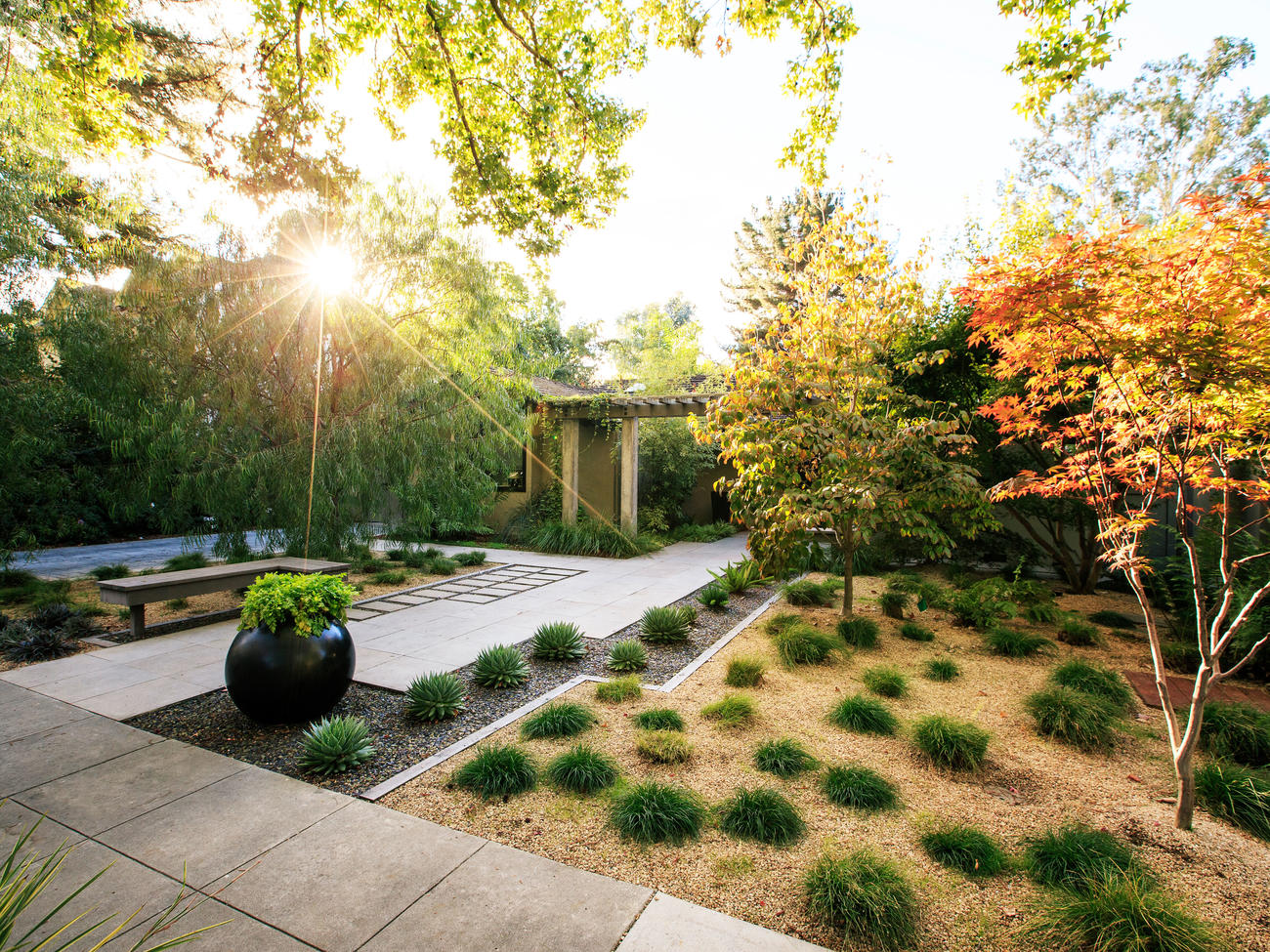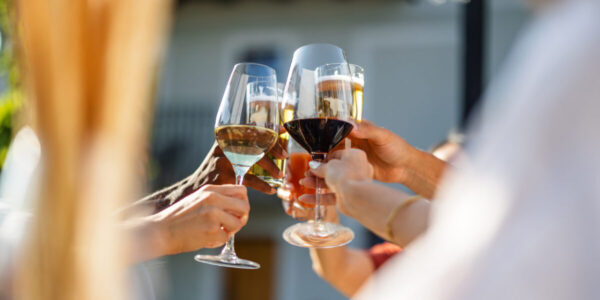
Small Trees That Don’t Have a Napoleon Complex
Not all trees have to tower. Find the perfect little tree for that small corner of your yard

Whoever said trees needed to be giant and majestic? Sometimes the best things come in small packages. Small trees also make beautiful specimens for containers.
Japanese maple (Acer palmatum)
Airy, delicate leaves make Japanese maples absolute showstoppers in any small space. Great in shade and containers, and some varieties have colored stems for winter interest. Japanese maples come in a variety of sizes, from those that are good bonsai candidates to types that can grow up to 50 feet tall. The key, then, is to make sure you’re bringing home the right variety. ‘Crimson Queen’ is a smaller one that doesn’t get taller than 10 feet. It also has beautiful, feathery, wine-colored leaves. It grows well in zones 5-8.
Dwarf Meyer Lemon Tree (Citrus × meyeri)
Lemons don’t grow everywhere in the West—they’re best in Zones 9 and 10. But in areas where they do grow, they’re relatively low-maintenance. Happily, a dwarf Meyer variety is available. Water this tree once a week during the dry season, fertilize when you can, and trim it when it gets unruly, and you can easily keep these trees healthy and under five feet tall. Trees of this size produce a manageable amount of fruit and their root system isn’t extensive—dwarf lemons can even be grown in containers.
Apple ( Malus domestica)
Many varieties of apple tree exist in dwarf form, having been miniaturized by grafting a cutting from a full-sized tree onto dwarf rootstock. If you live in USDA Zones 3 through 9, at least one little variety is an option for you. Dwarf apple trees will usually stop growing when they’re 10-12 feet tall. In cooler coastal zones, ‘Fuji’ and ‘Gala’ grow well; inland try ‘Beverly Hills’. One note, though: Each apple tree occupies a fairly small footprint in your yard—in fact, their root systems are so weak and shallow that the trees will tip over without staking. But they don’t self-pollinate, so you’ll have to plant two—one male; one female. Nursery staff can help you figure out which is which.
Crape Myrtle (Lagerstroemia spp.)
This small tree with the fireworks-burst of blossoms grows well in warmer parts of the West, especially zones 7-9. ‘Acoma’ is a highly recommended variety. It seldom tops out at over 10 feet tall, and it’s happier with cold than other Crape Myrtles are. As long as your winter temperatures don’t go below zero, you’ll be able to enjoy your tree’s cloud of white flowers all summer. And amazingly, Crape Myrtles put on a fall foliage show, as well. Many varieties turn a fiery red rarely seen in the West; the leaves on ‘Acomas’ usually turn dark purple. This is the signature plant for many hot-summer regions. It’s hard to beat the showy summer flowers, beautiful bark, and brilliant fall color.
Star Magnolia (Magnolia stellata)
Magnolias may be emblematic of the South, but many of us Westerners can enjoy them, too, as they will grow well in Zones 7-10. (Actually, some can take temperatures approaching zero, but those varieties need a lot of space.) Star magnolia is among the earliest to bloom; their fragrant, star-shaped blossoms emerge in late winter, a herald of spring before the leaves are even out. Another small magnolia that will add languid charm to your yard is the ‘Teddy Bear’ variety. It grows up to 20 feet tall but doesn’t usually spread to more than 12 feet in diameter, making it the magnolia most suitable for small spaces. Beware that the root system of a magnolia can be much larger than the canopy, so this isn’t the tree for a micro-plot. If you are able to make ‘Teddy Bear’ work for you, the reward is a tree that stays green all year and produces sweet-smelling big white blooms every spring.
Pear (Pyrus spp.)
As with apples, many common varieties of pear have been bred to produce dwarf and semi-dwarf trees, including ‘Bartlett’ and ‘Bosc,’ both of which get to be 12-15 feet tall (for dwarf fruit, ‘Seckel’ and ‘Forelle’ are darling and have superb flavor). They grow easily in Zones 4-9, making them a great choice for many Western gardeners. As with apples, you do need to make sure that you have room for two trees, a male and a female, if you want fruit. A quirk of most dwarf pear varieties is that they produce a surprising amount of fruit, up to a bushel per tree. (Don’t worry; we can help you find a use for all those pears.)
Vine Maple (Acer circinatum)
This Pacific Northwest native is a natural in any woodland garden or shady space. Nearly circular leaves are red-tinted when new, light green as they mature, and then orange, scarlet, or yellow in fall.
Hop-bush ( Dodonaea spp.)
This evergreen shrub, with fine, bronze foliage, can be trained into a tree. It’s an ideal addition to desert gardens.
Ornamental crabapple (Malus spp.)
Plant one of these for a lavish pop of white, pink, or red flowers each spring. Easy to care for in a woodland garden or as a street tree, birds and wildlife love the fruits.
Chinese fringe tree (Chionanthus retusus)
Named for the narrow, fringlelike white petals that are borne in a profusion of lacy flower clusters. These small trees are tolerant of air pollution, making them a good street tree.
Columnar Apple (Malus domestica)
If you’re not sure you even have the space for apples, consider a columnar apple tree. Like conventional apple trees, the columnar varieties produce some lovely blossoms in the spring, and a bit of foliage in fall. But their real value is in producing a surprising number of fruit-bowl ready apples on a slender trunk almost without branches. They grow to be about 8 feet tall but have such a slim profile and modest root growth that they can be cultivated in containers. They grow best in zones 8 and 9—but note that as with most apple trees, you’ll need a male and a female tree if you want fruit. Varieties with ‘Spire’ in the name (‘Emerald Spire’, ‘Crimson Spire’, and ‘Ultra Spire’, for example) are particularly hardy and low-maintenance.
Saucer magnolia (Magnolia × soulangeana)
Magnolias are magnificent flowering plants featuring blossoms in white, pink, red, purple, or a more recent development, rich yellow. They can take a bit of shade.
Kousa dogwood (Cornus kousa)
This easy-care dogwood species makes a great multi-stemmed shrub or—with training—a small tree. The petal-like leaves are breathtaking in spring, and the fruits can be used to make wine. In general, dogwoods come in a range of sizes, from shrubs to 25-foot-tall trees, and thrive in Zones 5-9, so there’s one for most spaces. They’re popular for their striking flowers (usually white, but sometimes pink) that start off the spring blooming season. They’ll liven up the garden in the fall, too, when they turn a dark red and sprout berries that attract birds. Best of all, they’re fairly low maintenance. If you’ve seen photos of tidy, rounded dogwood canopies, you’ve probably assumed that it takes a lot of pruning to maintain the look, but in fact, they just grow that way. They don’t require much watering after they’re established, and you’re almost more likely to over-fertilize them than to feed them too little. ‘Wolf Eyes’ is another favored variety as it is a true tree that only grows to be about 10 feet tall. If you’ve got a bit more room, consider a C. florida var. rosea, which is almost twice as big but delivers beautiful pink flowers in the spring.
Dwarf Hinoki false cypress (Chamaecyparis obtusa)
Mature foliage has tiny, scale like, overlapping leaves that make a stunning layered look. Hinoki false cypress makes an outstanding container tree.
Mountain-Ash (Sorbus spp.)
Not a true ash (the plant is named for its pinnately compound leaves, similar to ash), this is an excellent choice if you want to add some color to your yard. Mountain-ash, also known as rowan, have clusters of pretty white flowers in spring that turn to bunches of bright orange berries that can last into winter. In fall, the foliage turns yellow and red. True to its name, the mountain-ash is good with altitude, though you don’t have to live in the mountains, just in the relative cool of Zones 2-5. Mountain-ash will grow up to 30 feet tall (although 20 is more typical). They don’t spread out much, though, and most varieties are self-fertilizing, so you only need one. The only real downside to this tree is that it tends not to live long. During their lifetimes, they are remarkably low-maintenance. An added bonus is that many birds, such as the striking cedar waxwing (pictured), are attracted to the plentiful berries.
Peanut Butter Tree (aka Harlequin Glorybower; Clerodendrum trichotomum)
Do you have a “Keep [your city here] Weird” sticker on your vehicle? Then consider the Clerodendrum trichotomum. You may know this beehive-shaped, offbeat little specimen as a Peanut Butter tree, because, as improbable as it sounds, the fuzzy leaves emit the scent of peanuts when bruised. (Its other delightfully flamboyant common name is harlequin glorybower.) The small tree blooms late in the summer, elegant, fragrant white flowers that turn to red, star-shaped structures that eventually open to reveal a small, hard fruit that is an unearthly blue color. We told you; this one’s an oddball, but it’s an endearing and attractive one that will enliven even a fairly small corner of your yard. Peanut Butter trees grow to be 10-20 feet in height; they have a tendency to get wide and shrubby, but they can be trained to grow as a true tree, which takes up less space. Clerodendrum will be happy in Zones 7-10—and anywhere locals are encouraged to let their freak flags fly.
The Latest

